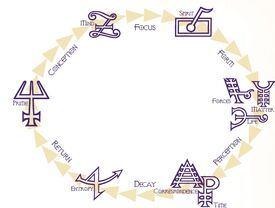A Sphere is a well-rounded knowledge of nine different yet interrelated elements of reality. In story terms, these nine constructs represent a sort of “unified field theory” of Earthly metaphysics. In game terms, they measure what mage characters do and cannot do, based upon their understanding of theoretical knowledge and practical results.
Overview
Spheres represent the divisions of the Tellurian - the divisions are largely artificial, but are fairly accurate in dividing the known universe into several distinct facets. Although the distinction was originally artificial, it's notable that each Sphere has its own associated Realm within the Umbra, matching up to one of the nine planets within the physical universe.
The Spheres have their origin in the court of Thothmes III and Hatshepsut, when they collected together sacred artisans and mystics from around the world into two organizations: the Reed of Djehuty and the Cupbearers of Aset. He declared nine Cornerstones of Creation, the building blocks of reality.
When the Reed and Cupbearers disbanded, the knowledge of the Cornerstones was lost for a time, with various fellowships utilizing their own Pillars and Ars which were completely incompatible with each other. In the late middle ages/early Renaissance, two seperate groups — the Order of Reason and the Council of Nine Mystic Traditions — arose which used these nine Cornerstones, renaming them Spheres.
Each mage has a particular Affinity Sphere that often manifests during the Awakening, but can also express itself in the interests and personality of a mage. For this reason, many mages are drawn to a paradigm that grants special weight and insight to their Affinity Sphere, although exceptions do exist in every case.
Interaction

A model of the Sphere system
The nine Spheres are interconnected, each feeding the others in process referred to as Transmogrification. Higher levels demand that Spheres be used in conjunction. If a particular Sphere aligns with the same aspect of the Metaphysical Trinity, the mage can even imitate effects from this Sphere with another Sphere of the same spectrum that he has mastered. This is, in general, possible regardless of paradigm, provided that the paradigm accepts the model espoused by the major magical factions.
The Nine Spheres
The nine spheres, and the fields they control, are as follows:
- Connection - the element of connection between apparently different things.
- Entropy - the principle of chance, fate and mortality.
- Forces - the understanding of elemental energies.
- Life - keys to the mysteries of life and death.
- Matter - the principles behind supposedly “inanimate” objects.
- Mind - exploration of the potentials of consciousness.
- Prime - an understanding of the Primal Energy within all things.
- Spirit - comprehension of Otherworldly forces and inhabitants.
- Time - the strange workings of chronological forces and perceptions.
- Most Traditions postulate the existence of a Tenth Sphere, but what exactly it entails is a matter of debate.
In modern days, the spheres are largely the same — although the sphere of Connection has been renamed as Correspondence.
Technocracy
Although Spheres are properly referred to using the capital S, modern Technocrats use the lower-case s when referring to their "spheres of reality." These spheres are treated as different scientific disciplines, like biology, physics, psychology or astronomy. Additionally, modern Technocrats do not practice Spirit, instead utilizing their own variant they've dubbed Dimensional Science. Other variants include the sphere of Data, which shares aspects with Correspondence, and Primal Utility, a variant of Prime.
Nephandi
Although the Nephandi still practice regular mystic Spheres, they also practice their own twisted versions known as Qlippothic Sphere. Each Sphere has its own associate Qlippoth: while normal Spheres operate by creating, changing and rearranging elements of reality, Qlippothic Spheres operate by reality's destruction. A normal portal might temporarily "sew" together two places in the Tapestry, but a portal created through Qlippothic magic would literally tear a hole in space, negating the space between two locations.
Optional: Minor Sphere
Minor Spheres are possible variants of Spheres that focus on a particular aspect of a major Sphere, similar to Path-based Linear magic. Minor Spheres have clear capabilities and areas of influence (for example, Fire, Terror, Domination or Healing) that encompass their possible Effects. While not as flexible and easily to combine with other Spheres, Minor Spheres allow mages to develop a niche for a particular application of a Sphere within his personal paradigm without having to clearly define and incorporate every single aspect of it.
References
- MTAs: Mage Storytellers Handbook

 , p.26-30
, p.26-30 - MTAs: Mage: the Ascension 20th Anniversary Edition

 , p.64-67
, p.64-67
| Mage: The Ascension Spheres | |
|---|---|
| Traditional: | Correspondence · Entropy · Forces · Life · Matter · Mind · Prime · Spirit · Time |
| Variations: | Data · Dimensional Science · Primal Utility · Void Correspondence · Qlippothic Spheres |
